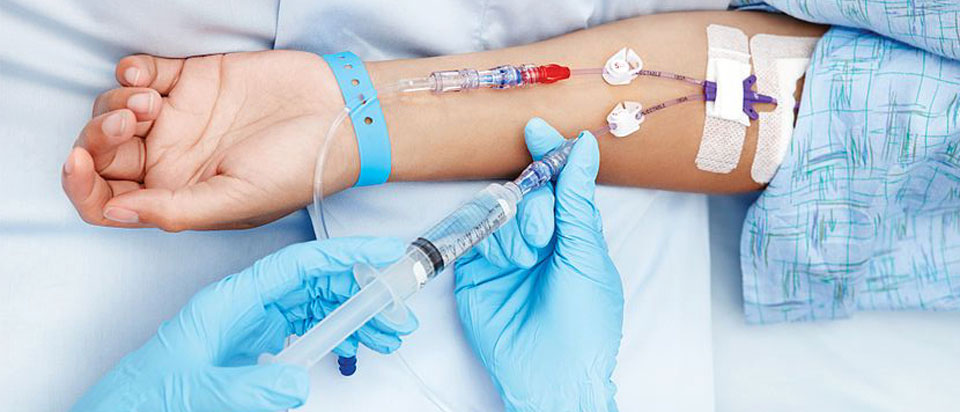PICC

What is a Peripherally Inserted Central Catheter (PICC)?
A PICC is a long intravenous catheter inserted into a vein above your elbow. The tip of the catheter sits in the lower 1/3 of the Superior Vena Cava, a large vein near the heart. The location of the PICC tip is very important and allows for adequate mixing of intravenous medications in the bloodstream.
Benefits Of Having A PICC
If long-term central venous access is essential for your treatment, a PICC line is the answer. A PICC is ideal for managing patients requiring chemotherapy, long term antibiotics, parental nutrition (PN) and with “difficult” venous access. A PICC can adequately and safely meet these requirements for short- to long-term therapy in many clinical settings.
A patient assessment is essential to ensure the most appropriate device is used to deliver your treatment with minimal complications and an optimal outcome.
If you require vascular access services for PICC insertion, please complete the online referral form or contact us.
The advantages of having a PICC include the following:
Long-term vascular access:
Short-term peripheral intravenous cannulas (PIVCs) need to be removed as clinically indicated, normally within a week. PICCs can remain in place for many weeks, months, even up to a year. Correct care and maintenance will ensure minimal complications and the longevity of the catheter.
Reduced risk of infection:
PICCs carry a low risk of infection as they are inserted using a sterile technique and maximum sterile barriers. The skin is cleansed with 2% chlorhexidine 70% alcohol which reduces the risk of infection. Because the PICC is placed in the upper arm, there is also a reduced risk of infection and less risk of catheter contamination, unlike other sites used, for instance in the groin or the neck.
Fewer venous punctures for blood sampling:
PICCs can be used to obtain blood samples during treatment. Not only does this decrease the risk of potential infection, it also reduces stress, anxiety and discomfort around repeated blood tests for patients.
Early patient discharge:
PICCs can be managed at home by the patient who has received appropriate training, or by a District Nurse. Patients can also be discharged back to nursing home care facilities and continue their treatment there, instead of in the hospital. Infusion Healthcare offers support to both patient and staff to ensure a smooth discharge and aftercare with minimum complications and/or disruptions to treatment. Infusion Healthcare uses the best technically advanced PICC which only requires weekly flushes, and no heparin.
Versatility:
PICCs can be used for the administration of antibiotics, chemotherapy, blood products, parental nutrition, intravenous fluids and contrast dyes at high pressure (Power PICC) without compromising the PICC line. Multiple infusions can be given simultaneously via a multi lumen catheter.
How Is A PICC Inserted?
A PICC is inserted in the hospital, clinic or radiology setting at a time to suit you and your clinical team.
The Infusion Healthcare RN will use an ultrasound machine to examine your arm and visualise your veins. A decision will be made by the RN as to which arm and vein to use.
The procedure is an aseptic technique which helps reduce microbes and the risk of infection. Your arm is cleansed with antiseptic prior to cannulating the vein. Local anaesthetic is used at the site to numb the area where the needle is inserted. Once this has taken effect, the remainder of the procedure should be relatively pain free and comfortable.
The correct tip of the catheter is determined by ECG (cardiac wave form), or fluoroscopy (live x-ray). Both methods will be explained prior to your procedure.
Following tip confirmation, the PICC is secured and covered with a sterile, transparent dressing. The catheter is now ready for immediate use.

PICC Line Removal
Once your treatment is complete, your PICC will be removed. A nurse will do this at your home, at an infusion centre, an outpatient department, or in the hospital. It will be removed gently using an aseptic technique and covered with an occlusive dressing. This is a painless procedure and strenuous activity should be avoided 30-60 minutes post removal. The dressing can be removed within two days once the site has healed.
Experienced Vascular Access Team
If you require vascular access services for PICC insertion, please complete the online referral form or call 0800 PICC US (0800 7422 87). We look forward to working with you to help make patient care better – together!
Risks Of Having A Peripherally Inserted Central Catheter (PICC)
Procedural and post complications are low. However, the following may occur:
- Slight discomfort at site of insertion during the procedure.
- Bleeding at the insertion site.
- It may take more than one attempt to cannulate the vessel and may not be possible to insert the entire length of the PICC.
- Accidental puncture of an artery, nerve, or tendon can occur near the insertion site. This event is rare.
- A clot (thrombosis) may form around the catheter in the vein, which can cause swelling and pain in the arm.
- Inflammation of the cannulated vein (phlebitis) can develop from the use of all types of PIVC’s, including PICCs.
- An infection may occur at the insertion site or in the bloodstream.
- The PICC can come out partially or completely, if not well-secured and completely covered. Infusion Healthcare choses to use the latest products to prevent catheter movement.
- If the PICC moves out of position in the vein, it may need to be removed or repositioned.
- The PICC may become blocked. Medication may need to be used to clear the blockage.
- The PICC could break and cause an embolism.




